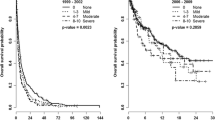Summary
The treatment of dyspnoea is a considerable challenge in palliative care. Respiratory problems, besides pain, belong to the most common symptoms of terminally ill patients. Invasiveness of diagnostic measures and treatment options demand a critical evaluation of the patient's burden and the expected relief by the therapy. On the basis of a case study of a lung cancer patient, the complexity of different causes of dyspnoea will be discussed. Special consideration will be taken to the psychosocial dimension of dyspnoea.
Zusammenfassung
Die Therapie der Atemnot stellt in der palliativmedizinischen Betreuung eine besondere Herausforderung dar. Respiratorische Symptome gehören neben Schmerzen zu den häufigsten Beschwerden von Palliativpatienten. Diagnostik und Therapie der Atemnot erfordern ein kritisches Abwägen von Zumutbarkeit und zu erwartendem Therapieerfolg. Kausale Therapieansätze sind von symptomatischen Behandlungsstrategien zu unterscheiden. Anhand eines Patientenbeispieles wird die Komplexität der Ursachen für Atemnot bei einer Patientin mit fortgeschrittenem Bronchialcarcinom dargestellt. Die Möglichkeiten der Therapie werden unter Berücksichtigung der psychosozialen Dimension von Dyspnoe diskutiert.
Similar content being viewed by others
Literatur
American Thoracic Society. Dyspnea. Mechanisms, assessment, and management: a consensus statement. Am J Respir Crit Care Med, 159: 321–340, 1999
Chan KS, Sham M, Tse D, Thorsen AB. Palliative medicine in malignant respiratory disease. In: Doyle D, Hanks G, Cherny N, Calman K (eds) Oxford textbook of palliative medicine. Oxford University Press, NewYork, pp 587–613, 2005
Deutsch J, Zdrahal F. Atemnot in der letzten Lebensphase. Wien Med Wochenschr, 156: 241–244, 2006
Reuben DB, Mor V. Dyspnea in terminal ill cancer patients. Chest, 89: 234–236, 1986
Hopwood P, Stephans RJ. Symptoms at presentation for treatment in patients with lung cancer: implications for the evaluation of palliativetreatment. The Medical Research Council Lung Cancer Working Party. Br J Cancer, 71: 633–636, 1995
Krech RL, et al. Symptoms of lung cancer. Palliative Med, 6: 309–315, 1992
Roller S. Beachtung, Bewertung und Behandlung von Atemnot in der Palliativmedizin. Z Arztl Fortbild Qualitatssich, 94: 579–585, 2000
Jonen-Thielemann I. Die letzte Lebenszeit unheilbar Kranker. DPG 2000: M1.1, 2000
Bruera E, Kuehn N, Miller MJ, Selmser P, Macmillan K. The Edmont Symptom Assessment System (ESAS): a simple method for the assessment of palliative care patients. J Palliat Care, 7: 6–9, 1991
Burdon JG, Juniper EF, Killian KJ, Hargreave FE, Campbell EJ. The perception of dyspnoea in asthma. Am Rev Respir Dis, 126: 825–828, 1982
Aulbert E. Palliative internistisch-onkologische Tumortherapie. In: Aulbert E, Zech D (Hrsg) Lehrbuch derPalliativmedizin. Stuttgart, Schattauer, pp 279–301, 1997
Baldinger C, Thaler J. Supportivtherapie in der Onkologie 2006. Akademie für Gesundheit und Bildung der Kreuzschwestern, pp 121–123, 2006
Klaschik E. Schmerztherapie und Symptomkontrolle in der Palliativmedizin. In: Husebø S, Klaschik E (Hrsg) Palliativmedizin. Springer, Berlin, Heidelberg, pp 181–187, 2003
Weixler D. Palliativmedizin-Sedierung von Sterbenden. In: Weixler D, Palitsch K (Hrsg) Praxis der Sedierung. Facultas Universitätsverlag, Wien, 2003
Brown ML, Carrieri V, Janson-Bjerklie, Dodd MJ. Lung cancer and dyspnoea: the patient's perception. Oncol Nurs Forum, 13: 19–24, 1986
Author information
Authors and Affiliations
Corresponding author
Rights and permissions
About this article
Cite this article
Doppler, K., Deutsch, J. Dyspnoe – ein multifaktoriell bedingtes, multidimensionales Symptom. Wien Med Wochenschr 158, 680–686 (2008). https://doi.org/10.1007/s10354-008-0628-6
Received:
Accepted:
Issue Date:
DOI: https://doi.org/10.1007/s10354-008-0628-6




